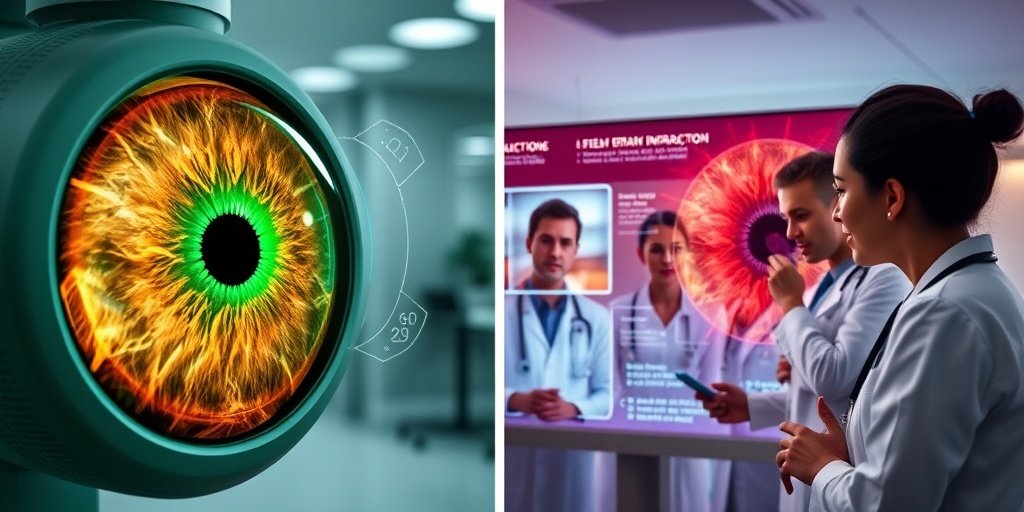⚡ Quick Summary
A novel deep learning system, DeepRETStroke, has been developed to detect silent brain infarctions (SBIs) and predict stroke risk using retinal images. This system demonstrated impressive performance with an AUC of 0.901 for predicting incident strokes, offering a non-invasive alternative to traditional brain imaging methods.
🔍 Key Details
- 📊 Dataset: 895,640 retinal photographs for pretraining; 213,762 for validation
- 🌍 Locations: Data collected from China, Singapore, Malaysia, the USA, the UK, and Denmark
- ⚙️ Technology: Deep learning model named DeepRETStroke
- 🏆 Performance: AUC of 0.901 for incident stroke prediction, 0.769 for recurrent stroke prediction
🔑 Key Takeaways
- 👁️ Retinal imaging can be a powerful tool for detecting SBIs.
- 💡 DeepRETStroke outperformed traditional clinical traits in predicting stroke events.
- 🔍 External validation showed consistent performance across diverse datasets.
- 🧠 Non-invasive approach eliminates the need for brain imaging in stroke risk assessment.
- 👥 Prospective study involved 218 participants with stroke for further validation.
- 📈 Potential for broader applications in stroke prevention strategies.

📚 Background
Silent brain infarctions (SBIs) are often undetected but can significantly increase the risk of future strokes. Traditional imaging techniques, while effective, are not practical for widespread screening in the general population. The integration of deep learning with retinal imaging presents a promising solution to this challenge, potentially transforming how we assess stroke risk.
🗒️ Study
The study aimed to develop a deep learning system, DeepRETStroke, to detect SBIs and predict stroke risk using retinal photographs. Researchers utilized a substantial dataset of retinal images, pretraining the model on 895,640 images and validating it with 213,762 images from various countries, ensuring a diverse representation of populations.
📈 Results
The DeepRETStroke system achieved remarkable results, with an AUC of 0.901 for predicting incident strokes and 0.769 for recurrent strokes. These metrics indicate a high level of accuracy and reliability in stroke risk prediction, surpassing traditional clinical assessments. The external validation confirmed the model’s robustness across different datasets.
🌍 Impact and Implications
The implications of this study are profound. By utilizing retinal images, DeepRETStroke offers a non-invasive, accessible method for detecting SBIs and predicting stroke risk. This advancement could lead to earlier interventions and improved patient outcomes, ultimately reducing the burden of strokes on healthcare systems worldwide. The potential for integrating such technology into routine screenings is exciting and could revolutionize stroke prevention strategies.
🔮 Conclusion
The development of DeepRETStroke highlights the transformative potential of deep learning in healthcare, particularly in stroke risk assessment. By leveraging retinal imaging, we can enhance our ability to detect silent brain infarctions and predict stroke events, paving the way for more effective prevention strategies. Continued research and validation of such technologies are essential for their successful implementation in clinical practice.
💬 Your comments
What are your thoughts on the use of retinal imaging for stroke risk assessment? We would love to hear your insights! 💬 Join the conversation in the comments below or connect with us on social media:
A deep learning system for detecting silent brain infarction and predicting stroke risk.
Abstract
Current brain imaging to detect silent brain infarctions (SBIs) is not feasible for the general population. Here, to overcome this challenge, we developed a retinal image-based deep learning system, DeepRETStroke, to detect SBI and refine stroke risk. We use 895,640 retinal photographs to pretrain the DeepRETStroke system, which encodes a domain-specific foundation model for representing eye-brain connections. Then, we validated the downstream clinical tasks of DeepRETStroke using 213,762 retinal photographs from diverse datasets across China, Singapore, Malaysia, the USA, the UK and Denmark to detect SBI and predict stroke events. DeepRETStroke performed well in internal validation datasets, with areas under the curve of 0.901 for predicting incident stroke and 0.769 for predicting recurrent stroke. External validations demonstrated consistent performances across diverse datasets. Finally, in a prospective study comprising 218 participants with stroke, we assessed the performance of DeepRETStroke compared with clinical traits in guiding strategies for stroke recurrence prevention. Altogether, the retinal image-based deep learning system, DeepRETStroke, is superior to clinical traits in predicting stroke events, especially by incorporating the detection of SBI, without the need for brain imaging.
Author: [‘Jiang N’, ‘Ji H’, ‘Guan Z’, ‘Pan Y’, ‘Deng C’, ‘Guo Y’, ‘Liu D’, ‘Chen T’, ‘Wang S’, ‘Wu Y’, ‘Yang D’, ‘Ran AR’, ‘Hamzah H’, ‘Chee ML’, ‘Yin C’, ‘Thinggaard BS’, ‘Pedersen FN’, ‘Peng Q’, ‘Quek TC’, ‘Goh JHL’, ‘Singh S’, ‘Abd Raof AS’, ‘Lee-Boey JWS’, ‘Lu Y’, ‘Huang S’, ‘Shu J’, ‘Yu S’, ‘Jin Y’, ‘Li T’, ‘Qin Y’, ‘Wang J’, ‘Yang X’, ‘Hu T’, ‘Wang Z’, ‘Zhao Y’, ‘Lee S’, ‘Wei X’, ‘Zheng H’, ‘Li Y’, ‘Shen J’, ‘Zhou Y’, ‘Lin S’, ‘Wu C’, ‘Dai R’, ‘Ruan L’, ‘Hogg RE’, ‘Wright D’, ‘Wang YX’, ‘Zheng Y’, ‘Tan GSW’, ‘Sabanayagam C’, ‘Bao Y’, ‘Zhang C’, ‘Zhang P’, ‘Zou W’, ‘Guo M’, ‘Yang X’, ‘McKay GJ’, ‘Grauslund J’, ‘Lim LL’, ‘Li Z’, ‘Cheung CY’, ‘Tham YC’, ‘Cheng CY’, ‘Wang Y’, ‘Dai Q’, ‘Jia W’, ‘Li H’, ‘Sheng B’, ‘Wong TY’]
Journal: Nat Biomed Eng
Citation: Jiang N, et al. A deep learning system for detecting silent brain infarction and predicting stroke risk. A deep learning system for detecting silent brain infarction and predicting stroke risk. 2025; (unknown volume):(unknown pages). doi: 10.1038/s41551-025-01413-9